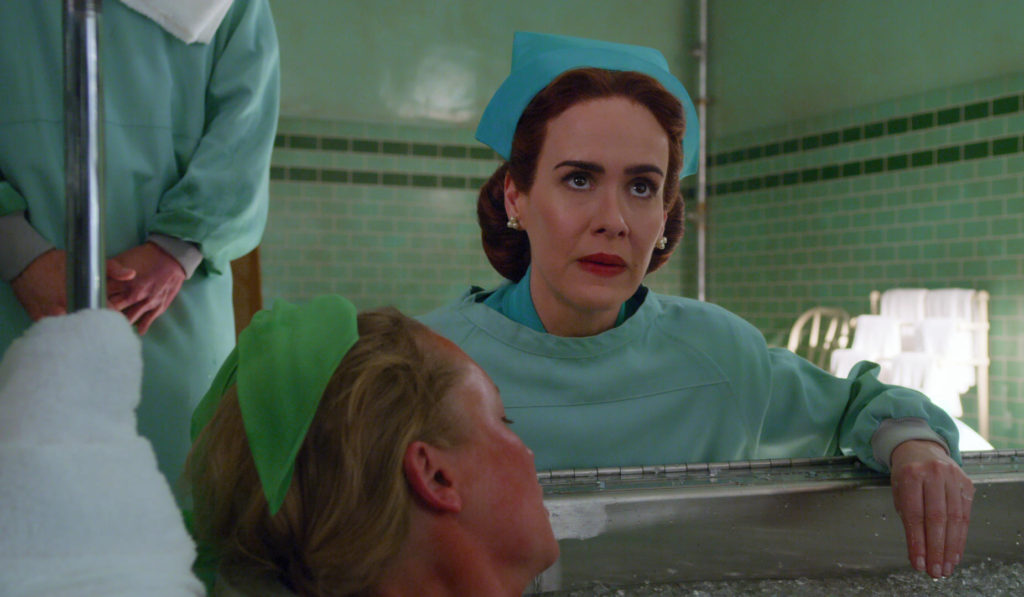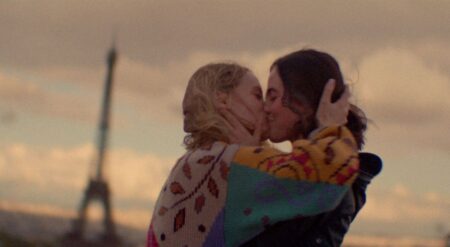
The character of Nurse Ratched looms large, in our culture. She’s the anti-thesis of gentle, nurturing femininity. She’s a severe meditation on the clinical coldness of the medical profession, as perceived in the 60s. For all these reasons and more, she’s an utterly fascinating choice for a character study. The villainous nurse has become an icon of literature and cinema, claiming a Top 5 position in the American Film Institute’s list of the greatest villains in film history. Netflix’s Ratched seeks to give the iconic baddie an origin story…and perhaps some redemption.
In the eight-episode first season, from creators Ryan Murphy (American Horror Story) and Evan Romansky, a young Nurse Ratched takes a position at a mental institution. The series stars Sarah Paulson as the titular Ratched, along with a star-studded ensemble including Jon Jon Briones, Cynthia Nixon, Judy Davis, and Sharon Stone. As the demands of the profession and petty politics of the hospital staff begin to wear on her, Ratched becomes jaded and bitter. When shocking secrets and horrific truths come to light, it’s soon understood that no one is free from Ratched’s firm control and her unorthodox notion of mercy. Who better than Ryan Murphy to wrap this fascinating, and some would say twisted, woman up in a stylish exploration of madness, vengeance, and medical malpractice?
As can be expected from any Ryan Murphy project, Ratched is an absolute feast for the eyes. The aesthetics of the film are rich and hover just on the edge of surreal. The clean, sterile lines of the hospital are broken up with vibrant colors and patterns. The hospital sets feature an odd sort of opulence that speaks to the corruption of caretakers whose heads are turned by the promise of power.
However, what is most striking in Ratched is one of the most decadent uses of green in (quite possibly) the whole of television. The character of Nurse Ratched is surrounded in this sort of poison green that shifts from cheery pastel to sickening by the mere shift of light. Much of the hospital mirrors this color palette of mint to emerald, creating an absolutely stunning visual. What makes the use of green even more interesting is the associations we come to connect the color to as the series progresses. Green is a color that wraps itself around sickness, and corruption, and money, and decadence, and wickedness. Sometimes it exists as a teasing scarf, a subtle warning. Sometimes sickly greens wash over an entire set, spotlighting a monstrous act. It’s incredibly thoughtful work and probably one of the more intelligent and intentional designs that Ryan Murphy has put forth, but no less vivacious than his usual offerings.

That being said, Ratched’s beauty is more than skin-deep. Granted, the series does fall short in many areas, but one thing that Ratched does really well is how it explores the strange world of women. As mentioned at the outset, part of what makes Nurse Ratched such an upsetting character is that she takes the traditionally feminine and nurturing role of the nurse and transforms it into something cold and vindictive and dangerous. That’s an unsettling thought. It’s also a direct confrontation of female expectations, especially for the time period. Ratched’s take unflinchingly allows Nurse Ratched’s femininity to be equally soft and hard. The layers of her womanhood are complicated and constantly shifting. She’s capable of incredible compassion and tenderness and, in the next moment, can be cruel.
Wrapped up in its portrayal of women, Ratched slips in some pointed commentary on emotional labor and LGBTQ+ matters. I’d argue that the crux of Ratched is to identify the emotional work that women are charged with. It is not enough to be a physical caretaker and nurse, but every woman in Ratched is saddled with managing everything in a man’s life from their schedule and administrative needs to helping them carry the weight of their emotional hardship. Much more time in Ratched is spent watching these nurses soothe the ego and clean up the messes of the doctors and politicians in the show than care for any number of patients. When combined with the timid exploration of lesbian desire and relationships, Ratched positions itself as a story that’s all woman.
Despite all the sumptuous detail and style, and interesting threads of discussion, Ratched lacks confidence. The series takes a long time to find its footing and, more importantly, its purpose. Ratched takes a few obvious stabs at insincere political theatre and corruption, as well as the shortcomings of mental health care, but these discussions are shallow and ill-executed.
In the same vein, the show’s use of trauma as a driving factor in madness and vengeance comes off as insensitive and willfully ignorant of many mental health realities. Ratched has the straightforward goal of contextualizing the circumstances that would nurture a wicked character, while also humanizing a stereotype of cruelty. It just never finds its footing or settles on a method for furthering that goal. By the end of the series, all of those individual great moments begin to resemble a scatter plot – no cohesive or compelling trend emerges.
Sarah Paulson’s performance as Nurse Ratched is the anchor that focuses the entire series. It’s a performance built on subtleties and Paulson pulls it off incredibly well. As far as Ratched‘s treatment of its iconic subject, the verdict is mixed. As an origin story, Ratched is interesting and provocative. In my opinion, dear Reader, the entire series could have been much better served by focusing on Ratched as an unconventional woman hellbent on surviving in a man’s world. Those are the moments that make the show great, everything else is just noise.
Ratched spends much of its eight episodes stumbling down frustrating departures but eventually finds its stride towards the end of the season. The performances alone are worth a watch and, as a character study, Ratched offers up so much to fans of the sinister nurse. At the end of the day, a more than worthwhile watch.
All eight episodes of Ratched will premiere on Netflix on September 18, 2020.
Ratched
-
Rating - 6/106/10
Summary
Ratched spends much of its eight episodes stumbling down frustrating departures but eventually finds its stride towards the end of the season. The performances alone are worth a watch and, as a character study, Ratched offers up so much to fans of the sinister nurse. At the end of the day, a more than worthwhile watch.






